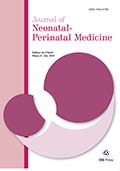Authors: Viswanathan, S. | Merheb, R. | Wen, Xintong | Collin, M. | Groh-Wargo, S.
Article Type:
Research Article
Abstract:
BACKGROUND: Compared to early enteral feeds, delayed introduction and slow enteral feeding advancement to reduce necrotizing enterocolitis (NEC) is not well studied in micropremies (<750g birth weight). METHODS: Pre-post case control study. Micropremies who followed a standardized slow enteral feeding (SSEF) protocol (September 2009 to March 2015) were compared with a similar group of historical controls (PreSSEF, January 2003 to July 2009). Enteral feeding withheld for first 10–14 days and advanced at <10 ml/kg/day in the SSEF group. RESULTS: Ninety-two infants in the SSEF group were compared with 129 PreSSEF group. Birth weight and gestational age
…in SSEF and PreSSEF were similar. Breast milk initiation rate was higher in SSEF (87.0 vs. 72.0%, p = 0.01) compared to PreSSEF, but were similar at full enteral feeds. Compared with PreSSEF, feeding initiation day, full enteral feeding day, parenteral nutrition days, and total central line days were longer in SSEF. There was significant reduction in NEC (1.1 vs. 16.2%, p < 0.01), surgical NEC (0.0 vs. 7.8%, p < 0.01) and NEC/death (7.6 vs. 29.5%, p < 0.01), in SSEF compared to PreSSEF. SSEF, compared to PreSSEF, had more cholestasis (41.8 vs 28.8%, p = 0.04), higher peak serum alkaline phosphatase (638 vs. 534 IU/dL, p < 0.01), but similar rates of late-onset sepsis (39.1 vs 43.4%, p = 0.53). In infants who survived to discharge, SSEF had higher discharge weight, lower extra-uterine growth restriction, and similar length of stay, compared to PreSSEF. CONCLUSIONS: A SSEF protocol significantly reduces the incidence of NEC and combined NEC/death in micropremies.
Show more
Keywords: Enteral feeding, necrotizing enterocolitis, premature infants, micropremies
DOI: 10.3233/NPM-171680
Citation: Journal of Neonatal-Perinatal Medicine,
vol. 10, no. 2, pp. 171-180, 2017
Price: EUR 27.50




